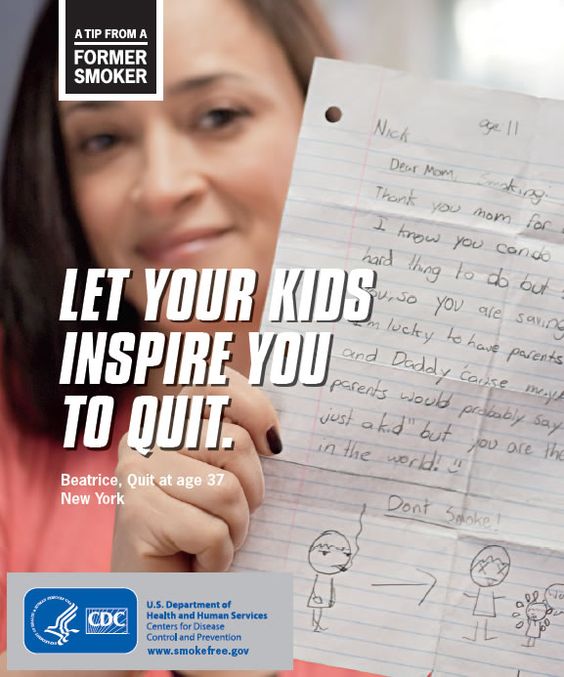It can be very hard to quit using tobacco products. Knowing that it will help improve the health of your children may help give you more motivation to quit and stay free from tobacco. There are many options out there to assist you in your quit efforts.
Note: Though the information below talks mostly about smoking, the information can be helpful for users of other tobacco products as well.
Reasons to Quit
 Take your pick! Quitting smoking is one of the best things you can do for yourself and your loved ones. Smoking not only harms your health, but it hurts the health of those around you: exposure to secondhand smoke increases the risk of lung cancer and heart disease in healthy nonsmokers. Babies and children raised in a household where there is smoking have more ear infections, colds, bronchitis, and other lung and breathing problems than children from nonsmoking families.
Take your pick! Quitting smoking is one of the best things you can do for yourself and your loved ones. Smoking not only harms your health, but it hurts the health of those around you: exposure to secondhand smoke increases the risk of lung cancer and heart disease in healthy nonsmokers. Babies and children raised in a household where there is smoking have more ear infections, colds, bronchitis, and other lung and breathing problems than children from nonsmoking families.
When you quit smoking, your body will immediately notice the difference. Your blood pressure will return to more normal levels, and your sense of taste and smell will begin to improve. Your risk of diseases will decrease. Your clothes and home will smell better. You will save money. You will have accomplished a major goal that takes a lot of strength and effort to meet.
Whatever your reasons are to quit, write them down. Several times. Put those reasons around in places where you usually keep your tobacco products (next to the door where your cigarettes used to be, on the patio table where you can of dip was, in the pocket of your purse where you kept your lighter). When you reach for your tobacco products without thinking, you'll instead find your reasons to quit, and this will help you resist the urge.
Cessation Aids
There are pills, lozenges, patches, inhalers, and gum that may help you gradually decrease your tobacco use. Some people prefer to use these items to aid them in gradually becoming independent from tobacco. As several of these aids require a prescription, you may need to speak to your doctor.
Tips, Tricks & Tools
No matter how tough quitting seems, remember that you are not the first to try it. Many other people have quit, and can offer insight and helpful advice to aid your efforts, including:
Do-it-yourself Quit Plans
If you do not want to go to an in-person group, or that is not an option, you can use online tools to help keep you on the path to quitting. One example is The EX Quit Smoking Program.
Specific Populations
Some groups of people have a more difficult time quitting than others. There are quit resources created especially for these groups.
Group Forums
These communities will enable you to exchange thoughts, ideas, and encouragement with others who are trying to quit:
Other Resources
1-800-QUIT-NOW — a toll-free number that can be called anytime, from anywhere, to get help with staying quit.
State-specific information from the AAP — Information about contacts within each state, including the state's tobacco control program, and a listing of county health departments which may be able to assist with in person cessation and support groups.
SmokefreeTXT — For anyone who would rather get their quit info via text message, SmokefreeTXT sends six weeks of quit texts to the person's cell phone. While the program was designed for teenagers, it can be helpful to anyone, as messages are sent in a convenient format and the program can be accessed any time.